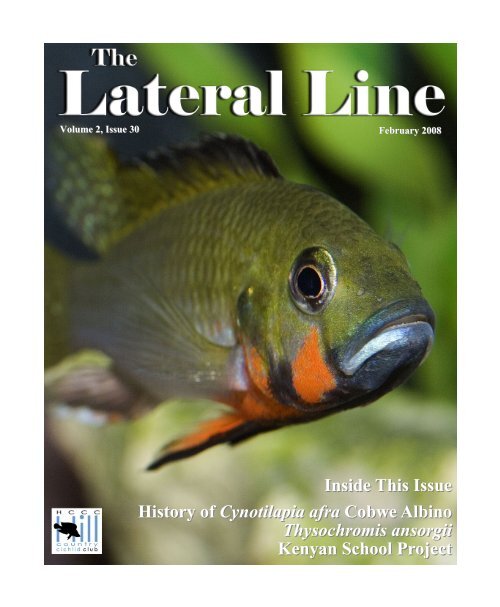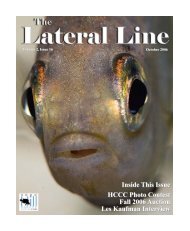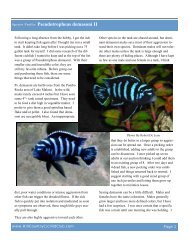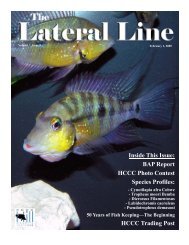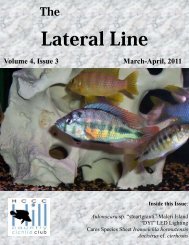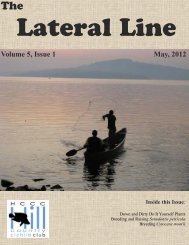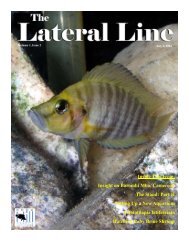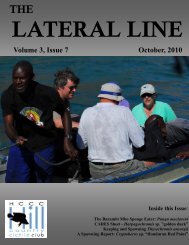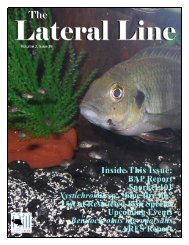February - Hill Country Cichlid Club
February - Hill Country Cichlid Club
February - Hill Country Cichlid Club
You also want an ePaper? Increase the reach of your titles
YUMPU automatically turns print PDFs into web optimized ePapers that Google loves.
Volume 2, Issue 30 <strong>February</strong> 2008<br />
Inside This Issue<br />
History of Cynotilapia afra Cobwe Albino<br />
Thysochromis ansorgii<br />
Kenyan School Project
The Lateral Line Page 2<br />
BAP Report<br />
<strong>February</strong> 19, 2008<br />
INSIDE THIS<br />
ISSUE:<br />
Cynotilapia afra 3<br />
Thysochromis ansorgii 7<br />
Kenyan School Project 9<br />
Though the beginning of the 2008 BAP year is on par with our 2007<br />
entries we should have a "bumper crop" this year. This is not hard to<br />
predict, if you look at the interest generated by new members and<br />
also the 3 "fish rooms" that are being constructed. As soon as Nick,<br />
Dan S and JB get their rooms situated, they should be cranking out<br />
the fry.<br />
The first entry this month comes from Greg (GAS) with his report<br />
on Astatotilapia calliptera. These are a first of species and he is holding<br />
on to the fry till they get large enough to travel. Congrats Greg.<br />
Dan (Dwschacht) jumped into January with two entries. They consisted<br />
of the Pseudotropheus acei "Yellow tail" and the Iodotropheus<br />
sprengerae. Congrats Dan. Also the "Yellow tails" gave me 5 extra<br />
points for 2nd generation fish, thanks Dan and keep them fry moving.<br />
Two more reports for January came from Pat (Nascar2). One entry<br />
was the Labidochromis flavigulis which is a first of species entry.<br />
The 2nd entry was the Ptyochromis sp. "salmon". Congrats Pat on<br />
both of your entries.<br />
■ Jim Beck<br />
2008 BAP Standings<br />
2008 BAP Standings cont.<br />
Name<br />
YTD<br />
Name<br />
YTD<br />
Cover Photo:<br />
Thoracochromis<br />
brauschi<br />
By Dave Hansen<br />
Nick 115<br />
Dan 105<br />
Pat 50<br />
Greg 45<br />
Evan 20<br />
Robert 20<br />
Lisa 15<br />
Jim 5
The Lateral Line Page 3<br />
Species Profile:<br />
History of Cynotilapia afra Cobwe Albino<br />
I am not usually a fan of albino forms of any<br />
species. Besides a few albino BN's kept for<br />
utilitarian purposes, these are the first, and still<br />
the only, albinos in any of my tanks. There are<br />
several reasons why this particular variation has<br />
Photo by Jennifer Prince<br />
caught my attention. One part of the allure this<br />
anomaly has for me is in its newness and in its<br />
'discovery' within the tight proximity of my<br />
circle of friends. Another part is that these guys<br />
are just flat-out stunning! You cannot walk past<br />
a tank housing a mature group of these fish<br />
without stopping to take a better, longer look.<br />
The fact that this is a naturally occurring deviation<br />
versus something like the cross used to<br />
achieve the OB Peacock has a huge impact on<br />
my desire to maintain, propagate and disperse<br />
their offspring. Because I think this beautiful<br />
fish is bound to become a sought after staple in<br />
the hobby and while they're still of relative recent<br />
development and of limited availability, I<br />
figure it's worthwhile to put together a bit of a<br />
history for them. Unfortunately, I have been<br />
unable to contact "Sharkie", as he is known on<br />
many forum boards, to go over and refresh my<br />
information on the early portion of this history.<br />
I'll have to go with Doc's, David Dockwiller's,<br />
and my best recollections and update<br />
if any discrepancies occur.<br />
Sometime in 2003, "Sharkie" purchased two<br />
pairs of WC C. afra Cobwe from Armkes. He<br />
housed them in a 110 or 125 with groups of<br />
Ps. polit, Ps. flavus, Met. msobo and other<br />
species. Each of the males set up a territory on<br />
opposite ends of the tank and each had a successful<br />
spawn that "Sharkie" was able to collect<br />
the fry from. "Sharkie" gave a trio of<br />
these F1s to Doc's mother for her Malawi<br />
tank. Sometime shortly after that, one of the<br />
males killed the other male and claimed the<br />
females for himself. The now trio of afras<br />
produced many spawns. "Sharkie" was transitioning<br />
into Lake Tanganyikan cichlids during<br />
the summer of 2004 and sold the remaining<br />
male and two females to me. He also included<br />
a very nice F1 female from the spawn of the<br />
deceased male in the deal. He'd added her to<br />
AquaTek Tropical Fish<br />
a proud supporter of the HCCC<br />
10% off Fish<br />
8023 Burnet Rd. # 1<br />
Austin, TX 78132<br />
(512) 450-0182
The Lateral Line Page 4<br />
the trio because she had such fantastic coloration<br />
for a female.<br />
Doc's F1 trio and my 'new' original group were<br />
quite productive in their new homes. Doc's trio<br />
produced a batch of fry that included three unusual<br />
looking individuals. As they got some<br />
to move away from Mbuna and into more<br />
Lake Tanganyikan and West African cichlids,<br />
so he ended up putting his entire breeding<br />
group up for sale. Evidently, someone in the<br />
central Texas area purchased the group. I have<br />
yet to see more batches of the F3 albino fry/<br />
juvies available through local channels however.<br />
I know of several individuals across the<br />
country who purchased males with the hope of<br />
crossing the albino males with normal females<br />
and starting their own lines. I've tried to stay<br />
in touch with a few of these folks and am attempting<br />
to contact some others---more about<br />
this later in the story.<br />
Photo by Nick Andreola<br />
size, Doc was able to see that they were albinos.<br />
While he had no luck getting these 2 males<br />
and single female to spawn, he was able to collect<br />
a complete new batch that had approximately<br />
25% albino fry. Assuming roughly 25<br />
fry from a normal spit, that would be 6 or 7<br />
albino fry per spit. Over the next 2 years, he<br />
was able to grow these and subsequent fry<br />
batches out and eventually get F2 albino<br />
X F2 albino spawns that produced 100%<br />
F3 albino fry. He established a solid<br />
breeding colony which produced quite a<br />
few fry. The albino C. afra Cobwe that<br />
began showing up on Aquabid, at Dave's<br />
Rare Aquarium Fish and at River City<br />
Aquatics during the mid-part of 2006<br />
were all from Doc's group. Towards the<br />
mid part of 2007, Doc also felt the urge<br />
Back to the original group I got from<br />
"Sharkie". I kept that group for several years<br />
and had many, many spawns from all three of<br />
the females. I've been able to trade, sell and<br />
just share fry/juvies from this group throughout<br />
those years. Towards the mid part of 2006,<br />
breeding had slowed significantly and the trio<br />
was beginning to show signs of aging. I kept<br />
about ½ of the last batches of fry from each of<br />
the females before putting them and the old<br />
male out to pasture in various friends tanks. I<br />
grew the combined group of fry out in a 40BR<br />
until the males began to color up. Unfortu-<br />
Dave’s Rare Aquarium Fish<br />
a proud supporter of the HCCC<br />
5121 Crestway Drive Suite 300<br />
San Antonio, TX 78239 (210) 599-9444<br />
Member discounts<br />
www.DavesFish.com
The Lateral Line Page 5<br />
nately, about this time a number of things were<br />
going on in my non-fish world that didn't allow<br />
me to spend as much time as I would have liked<br />
on this group and they began spawning in that<br />
tank -before I was able to thin down the heavily<br />
male population or to have a chance to<br />
collect any of the batches of fry. As normal<br />
in reasonably rocked tanks, there were a<br />
few survivors from each spit. I happened to<br />
note that one or two of these survivors had<br />
a very distinct look to them and on further<br />
scrutiny seemed to be albinos. I was unable<br />
traded off the rest; knowing that I had Doc's<br />
nice trio of albinos already. I moved the group<br />
to their new 75 and breeding began in earnest.<br />
As luck would have it, every spit from one of<br />
the four females produces albino fry! I have<br />
Photos by Nick Andreola<br />
to rescue them at that time and they evidently<br />
didn't make it out of the food chain. Meanwhile,<br />
Doc was kind enough to share a male<br />
and two female juvies from his line with me<br />
before he closed out his colony. I had no idea<br />
which of the pairings occurring in the 40BR<br />
had produced the albino fry and just flat didn't<br />
have the time or space to try a long-drawn-out<br />
process of elimination. So I thinned the F1<br />
group down to one male/four females and<br />
several of her batches growing out now.<br />
None of the other three female's spits<br />
have produced anything but normal fry. I<br />
haven't separated the young albinos from<br />
their normal brothers and sisters. All<br />
behavior within the group seems to be<br />
identical to any other batch of afra fry.<br />
There is a similar range in size and<br />
growth within the albinos; some are larger/quicker<br />
growers, some the opposite and<br />
most are in the middle.<br />
Darby’s Tropicals<br />
a proud supporter of the HCCC<br />
10% off Livestock & Plants<br />
5514 IH 35 South<br />
New Braunfels, TX 78132<br />
(830) 625-1122
The Lateral Line Page 6<br />
This chart shows what we’ve been able to deduce<br />
of the probable sequence of spawns. It<br />
appears that the loss of Male #2 was of more<br />
significance than any of us suspected at first. It<br />
is likely that he was the carrier of this trait and<br />
that his early demise really narrowed the window<br />
for someone like Doc to note and then<br />
save this anomaly.<br />
It was also very fortunate for "Sharkie" to have<br />
noted the uniqueness of that one F1 female<br />
because through her I now have a 50% different<br />
bloodline of albinos. I intend to follow<br />
Doc's lead and mate the F2 albinos and create<br />
100% broods and will hopefully have the opportunity<br />
to cross the two lines and create the<br />
'combo' line. I've called the unrelated WC x<br />
F1 offspring F2-some would call them F1-but<br />
it's not an argument necessary in the scheme<br />
of this article. As stated above, I'll continue to<br />
stay in contact with and try to reach out to a<br />
few other folks who are attempting to create<br />
their own 50% different bloodlines in the<br />
hopes of trading fry from each line and doing<br />
the best we can to keep the long term diversity<br />
and robustness of this truly beautiful variation<br />
of C. afra Cobwe alive, healthy and available<br />
in the hobby for years to come.<br />
■ Nick Andreola
The Lateral Line Page 7<br />
Species Profile:<br />
Thysochromis ansorgii<br />
The Thysochromis ansorgii fish I have are<br />
about 3 1/2" in length, but the species has been<br />
known to grow to 5" for the males and 4" for<br />
the females. They are an omnivorous species<br />
spawn and then subsequently eat the eggs.<br />
After about 2 months, I needed the 55 for<br />
other fish so I relocated the ansorgii into a 30<br />
gallon X-tall tank. This was to be the home of<br />
the ansorgii until they spawned, died or<br />
were sold due to frustration.<br />
I decorated the 30 gallon tank with a pot,<br />
an elevated platform that I made to increase<br />
the floor space. I also planted<br />
some Val grass and some Anubis plants<br />
to help the fish feel more relaxed and at<br />
home. Within 2 weeks again they<br />
spawned. I thought that the female ate<br />
Photo by Dave Hansen<br />
that lives in the slow moving waters of rivers<br />
and lakes. They have a wide spread distribution<br />
in the wild and are not endangered.<br />
I obtained my pair in the FOTAS Auction<br />
that was hosted by the <strong>Hill</strong> <strong>Country</strong> <strong>Cichlid</strong><br />
<strong>Club</strong> in September 2007. When I got home, I<br />
was limited in space so I was forced to<br />
quickly set up a 55 gallon as a temp home<br />
for the lone pair. I placed them in this tank<br />
and added one flower pot. The pair spawned<br />
within a day of the flowerpot addition, but the<br />
female didn't seem to know what to do with the<br />
eggs as she ate them within 2 days.<br />
I left them in this tank by themselves for a<br />
while, and every 2 weeks or so they would<br />
Photo by Daniel Schacht<br />
the fry again, but about 2 weeks later, I noticed<br />
free swimming fry. I counted about 50 of<br />
them. This was the point when I should have<br />
pulled the canister filter I had on the tank and<br />
set the tank up with a sponge, but instead, I<br />
just wrapped the intake of the canister with
The Lateral Line Page 8<br />
filter floss. Within 2 weeks I was down to 10<br />
fry. All had been sucked up into the filter even<br />
through the floss.<br />
Ansorgii are very bad parents. They do no protecting<br />
of the off spring so if you want the fry<br />
to survive the tank must be a species only tank.<br />
Most fish would also try to herd or corral the<br />
fry, but this species gives no regard to where<br />
the fry may wander.<br />
This is a very peaceful fish and should not be<br />
housed with the more aggressive fish that we<br />
often see in the hobby. I would think that suitable<br />
tank mates for this fish would be any<br />
number of tetras, plecos, and even some of the<br />
smaller barbs. However, if you plan on harvesting<br />
the fry, they must be alone in the tank.<br />
■ Daniel Schacht<br />
After a month, the parents started to<br />
exhibit strange behavior and coloration.<br />
The cause of this is unknown to<br />
me, but in response, I removed the 10<br />
fry to a 10 gallon tank with some<br />
Rusties that were half the size.<br />
I tried everything I could to get the<br />
parents to return to normal. The behavior<br />
was very shy in nature and<br />
they coloration was wrong. The fish<br />
were a dark gray color as if they were<br />
heavy stressed all the time. As time<br />
passed, the 30 gallon tank they were<br />
in did not fit into my fish room plan<br />
so I moved them into a 15 gallon tank that has<br />
the same foot print, but is half the height.<br />
The adults immediately returned to normal<br />
coloration, started to eat again, and behaved<br />
as they did when I obtained them. They<br />
have not started to breed again, but I have<br />
no doubt that they will soon enough.<br />
As far as sexing goes, the females are considerably<br />
smaller than the males and have a<br />
region of shiny silver scales right in abdomen.<br />
When the female is ready to spawn,<br />
the abdomen gets to be a very dark red.<br />
Photo by Dave Hansen<br />
Amazonia International<br />
a proud supporter of the HCCC<br />
Member discounts:<br />
20% off Fish & Live Plants<br />
10% off Tanks, Stands, Eheims & Eclipses<br />
25% off Filters & Powerheads<br />
4631 Airport #116 Austin, TX<br />
(512) 451-0958
The Lateral Line Page 9<br />
<strong>Cichlid</strong> Conservation:<br />
Kenyan School Project<br />
Most of us have a similar story of our introduction<br />
into the aquarium hobby. It usually begins<br />
with a stroll through a pet store or interest in a<br />
display tank at an office or friends home. Before<br />
long, we have our first tank and are seeking<br />
out information on all things aquatic. This<br />
information comes via books, the internet or,<br />
the best of all, joining an association. The<br />
wonderful thing about an association is that<br />
you are in the company of others who share<br />
your interests. Collectively, a group of people<br />
are usually able to accomplish more than an<br />
individual. I ask you to keep this in mind as<br />
you read further.<br />
I am very proud of my home aquarium society<br />
the <strong>Hill</strong> <strong>Country</strong> <strong>Cichlid</strong> <strong>Club</strong>. This is a little<br />
more than a group of friends who simply enjoy<br />
the hobby. We are in a good part of the country<br />
with a strong brotherhood of other aquarium<br />
clubs including the Texas <strong>Cichlid</strong> Association,<br />
Houston Aquarium Society, and Oklahoma<br />
Aquarium Association. We all operate under<br />
an umbrella organization called the Federation<br />
of Texas Aquarium Societies (F.O.T.A.S).<br />
Other areas of the country have similar organized<br />
structure. Our little area contains a high<br />
concentration of people who enjoy the cichlids<br />
from in and around Lake Victoria. Most cichlid<br />
aquarists are aware to some degree of the<br />
problems associated with Lake Victoria and the<br />
endemic cichlids there. In a nutshell, there are<br />
a number of man made problems that have<br />
been occurring in the area for decades. The<br />
end result is that many of the 600+ species<br />
(estimates at 200) that inhabit the great lake<br />
have gone extinct and many more are in peril<br />
of suffering a similar fate. There has to be<br />
something that we as hobbyists can do collectively<br />
to protect the fish we are captivated by<br />
from this region.<br />
In January of 2008, The HCCC members were<br />
treated to a talk by the premier scientist concentrating<br />
on the cichlids from Lake Victoria,<br />
Dr. Les Kaufman. In his talk, Dr. Kaufman<br />
expressed his frustration in that many of the<br />
perils in the region could be rectified if only<br />
people would take serious notice in the situation.<br />
He explained how a little money in the<br />
right hands could create a huge difference. Dr.<br />
Kaufman introduced us to a former graduate<br />
student of his, Dr. William Ojwang. Dr.<br />
Ojwang is a research scientist with the Kenya<br />
Marine and Fisheries Research Institute in<br />
Kisumu Kenya. Dr. Kaufman explained how<br />
Dr. Ojwang had begun purchasing aquariums<br />
to be used in the schools of the region. These<br />
aquariums hold native fish from Lake Victoria<br />
and are used as an educational tool showing<br />
the children what beautiful creatures live in<br />
Pet Frontier<br />
a proud supporter of the HCCC<br />
15% off total purchase<br />
excluding specials, package deals and sale items<br />
12315 Wetmore Rd.<br />
San Antonio, TX 78248<br />
(210) 653-8880
The Lateral Line Page 10<br />
the massive lake. Educating the people populating<br />
the region is a major step forward to the<br />
eventual goal of saving the native fauna. Dr.<br />
Ojwang is making a huge impact with very<br />
little money. If he had more capital to work<br />
with, one could only speculate what could be<br />
done. The <strong>Hill</strong> <strong>Country</strong> <strong>Cichlid</strong> <strong>Club</strong> is taking<br />
Photo courtesy of Dr. W.O. Ojwang<br />
this opportunity to "change the world" very<br />
seriously. What makes this different from any<br />
other charity? Dr. Kaufman has set up a currency<br />
transfer to seamlessly send funds to Dr<br />
Ojwang. There is no administration fees, no<br />
hands involved in money distribution, just one<br />
man, who knows better than anyone, where<br />
funds could be best spent. We are presently<br />
involved in fund raising to support this fantastic<br />
cause. This is just the beginning and we<br />
hope to have a website up soon to keep the<br />
world abreast of our efforts.<br />
The support that has been relayed in such a<br />
short period of time has been outstanding.<br />
From the Association of Zoos and Aquariums<br />
(AZA), Moody Gardens are exploring ways to<br />
become involved as are other institutions. It's<br />
my hope that the aquarium hobby can lead the<br />
way with fund raising for this cause. We have<br />
a phenomenal role model to follow. The<br />
B.I.T.C.H.'s (Babes in the <strong>Cichlid</strong> Hobby)<br />
have been highly successful in their efforts<br />
involving cichlid conservation. If we could<br />
enjoy just a fraction what their efforts yield, a<br />
huge impact could be made. I would like to<br />
call on all organizations, local, regional and<br />
national, to generate efforts aimed at supporting<br />
this project. The first venture of the <strong>Hill</strong><br />
<strong>Country</strong> <strong>Cichlid</strong> <strong>Club</strong> involved members donating<br />
items to our <strong>February</strong> auction. We<br />
were able to net over $400.00 to the cause<br />
with little effort.<br />
As many of you are aware, the C.A.R.E.S.<br />
(Conservation Awareness Recognition Encouragement<br />
Support) program is involved<br />
with cichlid conservation. Under the guidance<br />
of Claudia Dickinson, we hope to integrate the<br />
Kenyan institutions with schools in the United<br />
States that have already initiated a curriculum<br />
that includes the maintaining and breeding of<br />
endangered cichlid species, many from the<br />
Victorian Basin. The Aqua Havens project<br />
has been a huge success thus far and will be<br />
our first US school involved in exchanging<br />
dialogue with their Kenyan counterpart.<br />
Lisa’s Lair Bookstore<br />
Online Books<br />
Various Discounts for<br />
HCCC Members<br />
www.lisaslairbookstore.com
The Lateral Line Page 11<br />
Aside from the good feeling of helping to make<br />
real progress with the situation in Lake Victoria,<br />
what's in this for the cichlid hobbyist?<br />
There are hundreds of beautiful cichlids Lake<br />
Victoria that have never made it into the hobby.<br />
This is a shame as these fish make ideal aquarium<br />
residents. They are relatively small, extremely<br />
colorful, and most take well to living in<br />
captive conditions. What a tragic loss it would<br />
be if more of these animals were to sink into<br />
oblivion without us ever having a chance to<br />
enjoy them. So long as they are being maintained<br />
by someone, and hopefully propagated,<br />
there is always a chance these fish will make it<br />
into the aquarium trade. These students are the<br />
next generation of caretakers for this region. If<br />
enough children are educated in the pitfalls of<br />
what destructive activities holds for their precious<br />
waters, they will be the ones to innate<br />
reforestation, sustained fisheries, industrial<br />
pollution accountability and a host of other<br />
problems the region sees today. This is our<br />
best chance.<br />
It is said to take one step at a time. That being<br />
the case, the first step is doing what is needed<br />
for Dr. Ojwang to continue his efforts. There<br />
are other associates in Tanzania and Uganda<br />
who share Dr. Ojwang's vision and are willing<br />
to do what they can to make a difference in<br />
The Hobby Palace<br />
a proud supporter of the HCCC<br />
10% off selected items<br />
5305 Bolm Road #3<br />
Austin, TX<br />
(512) 389-3833<br />
their countries as Dr. Ojwang has in his. The<br />
exchange of information between the African<br />
and Western schools will enhance the educational<br />
experience of students in both regions.<br />
This is a win-win situation for all parties involved.<br />
There exists a ready made infrastructure<br />
for the exchange of funds and information.<br />
We the hobbyists are the fuel that can<br />
really make this run. I urge you, the individual,<br />
the club, the regional and national organization,<br />
to make this happen. If any additional<br />
information is required, please contact any of<br />
the people listed below.<br />
Relevant websites:<br />
<strong>Hill</strong> <strong>Country</strong> <strong>Cichlid</strong> <strong>Club</strong> http://<br />
www.hillcountrycichlidclub.com<br />
C.A.R.E.S. http://www.carespreservation.com<br />
Aqua Havens http://<br />
www.washingtonpost.com/wp-dyn/content/<br />
article/2003/04/03/AR2005041902661.html<br />
Contacts:<br />
Greg Steeves gsteeves@gvtc.com<br />
JB Edmunston JOJBEDMUND@AOL.COM<br />
Claudia Dickinson ivyrose@optonline.net<br />
■ Greg Steeves<br />
Leslie’s Pool Supply<br />
a proud supporter of the HCCC<br />
20% off Pool Supplies<br />
5-20% off selected items<br />
All Locations<br />
Test kits and Pond Supplies
The Lateral Line<br />
Official Publication of the<br />
<strong>Hill</strong> <strong>Country</strong> <strong>Cichlid</strong> <strong>Club</strong>


